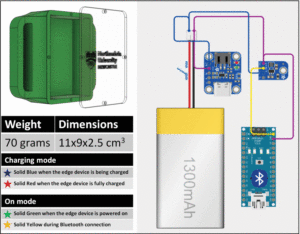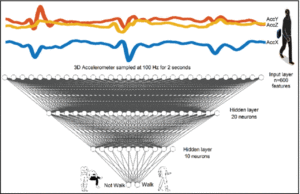Instrumented gait analysis plays a crucial role in clinical assessment and rehabilitation. Gait analysis can identify impairments, guide the development of effective rehabilitation programs, and inform strategies to improve overall function and quality of life. Specifically, instrumented approaches can better inform how individuals can walk with greater comfort and reduced pain.
Inertial sensors-based wearables, such as accelerometers, collect high-resolution data over prolonged periods—resulting in data that is expensive to store and time-consuming to process. Equally, streaming inertial data to a base station (like a smartphone) has its own challenges, such as high bandwidth requirements and high-power consumption. In an article published in IEEE Sensors Journal, researchers present a novel wearable edge device that overcomes those challenges by utilizing edge computing.
The developed edge device can collect and process raw data on the device and then only transfer the extracted gait characteristics to the cloud via a mobile phone connection for real-time monitoring. In the processing stage, the developed edge device detects walking/gait bouts and extracts step and stride durations, without requiring data storage and offline processing. Results suggest that the edge device is suitable for instrumenting gait in real-time and has the potential to be used continuously beyond the laboratory.

The article examines previous research in instrumented gait analysis and challenges with current technology, before discussing how those challenges could be mitigated by edge computing technology.
Utilizing Edge Computing Technology
Edge computing refers to the decentralization of computing power from the cloud/computer/mobile device to the edge of the network, where data are collected and processed closer to the source. Such an approach enables faster and more efficient processing of data, as well as reduced latency and bandwidth requirements. Furthermore, processing raw data directly on the device without data transmission minimizes the risk of inaccurate results due to data loss.
In this article, researchers introduce a low-cost edge device as a viable alternative to time-consuming and computationally complex gait analysis. The proposed edge device addresses the described challenges by leveraging artificial intelligence (AI) models with a previously validated software-level algorithm. Specifically, the proposed edge device can identify walking bouts and perform a real-time gait analysis to quantify steps and stride durations beyond the laboratory.
This low-cost device can operate for up to three days and requires a smartphone with Bluetooth and Internet connectivity to transmit data to a cloud platform using a mobile application available in the current digital markets. According to the researchers, edge computing can facilitate decentralized data processing, whereby raw data are collected and processed on edge devices.
This computing technique alleviates limitations related to raw data transmission, such as data loss, and offers real-time feedback capabilities for users. Furthermore, the proposed approach suggests a solution to privacy concerns by allowing individuals and organizations to maintain greater control over their data and minimize the risk of data leakage as raw data are processed and deleted on the device.

3-D case design of the device, featuring physical properties and LED Indicators, accompanied by electronic connection schematics.

Data collection protocol and NN structure used for walking activity recognition.
Case Study and Results
To assess the suitability of the proposed edge device, the researchers investigated validation against a reference system in a laboratory, with statistical parameters presented to explore the agreement between both systems. Additionally, a participant-specific examination was conducted, wherein an individual wore the edge device and the same reference for a day during routine daily activities. Results obtained from both wearables were analyzed and presented. The proposed system offers several advantages over traditional laboratory-based gait analysis systems.
The system can better reflect gait in habitual environments by capturing data in naturalistic settings. If a participant forgets to wear the sensor, a researcher can identify this through real-time analysis and then inform the participant. The system also minimizes the risks associated with data privacy and data loss as raw data are processed and deleted on the edge device.
Furthermore, it reduces the need for postprocessing data, as the edge device processes the raw data as it is collected, reducing bandwidth requirements and time spent on offline processing. The edge device offers a convenient and noninvasive way to gather real-time gait data in free-living environments. Preliminary findings from the case study indicate that the edge device is suitable for daily use and may serve as a practical tool during rehabilitation.
Limitations and Improvements
Considering the sensor usage in the case study, the battery life of the edge device lasts three days. Therefore, the edge device would need to be charged by mini-USB cable for longer assessment periods. Another limitation is the inability to detect specific data (step and stride durations). Future work will utilize different algorithms and compute other clinically significant characteristics (stance and swing durations).
The edge device also does not differentiate true right and left steps and cannot produce asymmetry and variability outcomes. Asymmetry and variability of an impaired gait could be informative in terms of diagnosis of certain neurological conditions and monitoring disease progression. Finally, the edge device validation was performed on healthy subjects only. Future studies will recruit people with Parkinson’s Disease and stroke survivors. In this context, we will employ models trained on data from a specific group of individuals with a particular medical condition.
Interested in learning more about Wearable Technology? IEEE offers continuing education with these course programs:
- Machine Learning: Predictive Analysis for Business Decisions
- Artificial Intelligence and Ethics in Design
- IEEE Introduction to Edge Computing Course Program
Interested in acquiring full-text access for your entire organization? Full articles available with purchase or subscription. Contact us to see if your organization qualifies for a free trial.





